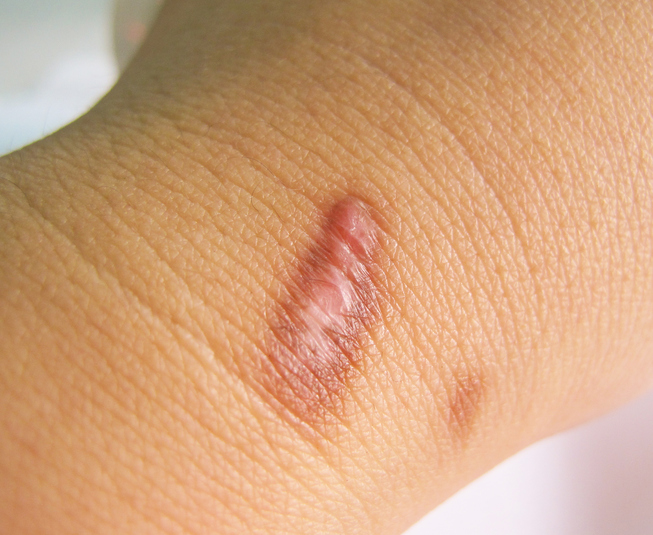
There are many different types of scars. One of the more common are referred to as Hypertrophic Scars, which are red in appearance and slightly elevated above the surrounding skin, often becoming quite itchy. In some cases, Hypertrophic Scars may even cause discomfort or pain. This is completely normal.
Hypertrophic scars start to develop within weeks of an injury, such as:
- Burn
- Cut
- Laceration
- Body piercing
- Surgical incisions
- Sport injuries
- Auto accidents
- Acne
However, the timeline varies from person to person. Some may take from six months to a year to form. When an injury occurs to the deeper layers of the skin, referred to as the Dermis, the body responds by sending Collagen to the wound site. This is nature’s way of repairing the injured skin. These scars can be red at first but often fade to a whitish hue over time. Even after turning white, they can still itch from time to time.
In contrast, Keloid scars are raised, reddish nodules that are more elevated than Hypertrophic scars. That’s because skin cells and connective tissue cells called Fibroblasts begin multiplying right after injury to the skin in order to repair the damage. And because a scar is comprised of connective tissue, these fibers help keep the wound closed. The thing with Keloids, though, is that the Fibroblasts keep multiplying, even after the wound is healed.
That’s why you’ll see a mound of scar tissue on top of the original injury site. Hypertrophic scars are more common than Keloids, with Keloids developing on only about 10 percent of people, according to the American Osteopathic College of Dermatology.
You’re more likely to experience Hypertrophic scars. They’re not as big and invasive, and are more likely to fade with time. Hypertrophic scars also respond better to topical scar treatment gels, creams and ointments.
A common method of treating Hypertrophic scars is the application of a topical silicone ointment like Scarfade. There are a number of these products available, and it is important to make sure you choose one that includes Silicone as its primary ingredient. Those with any less than 90% Silicone are less likely to be effective. These products help to regulate the body’s production of Collagen, preventing a buildup of scar tissue. You don’t need a prescription for most of these products, but it is important that you use them as directed. Scarfade also creates a micro-membrane of silicone that both protects and moisturizes the skin. It can be used both to help prevent scarring on new wounds and to treat scars that already exist.
Research shows Silicone gel can significantly decrease Hypertrophic scar volume when used over time, with between 80 and 100 percent improvement in scar formation, according to Medscape.
If you have a Hypertrophic or Keloid scar, try a proven topical scar treatment product like Scarfade.
